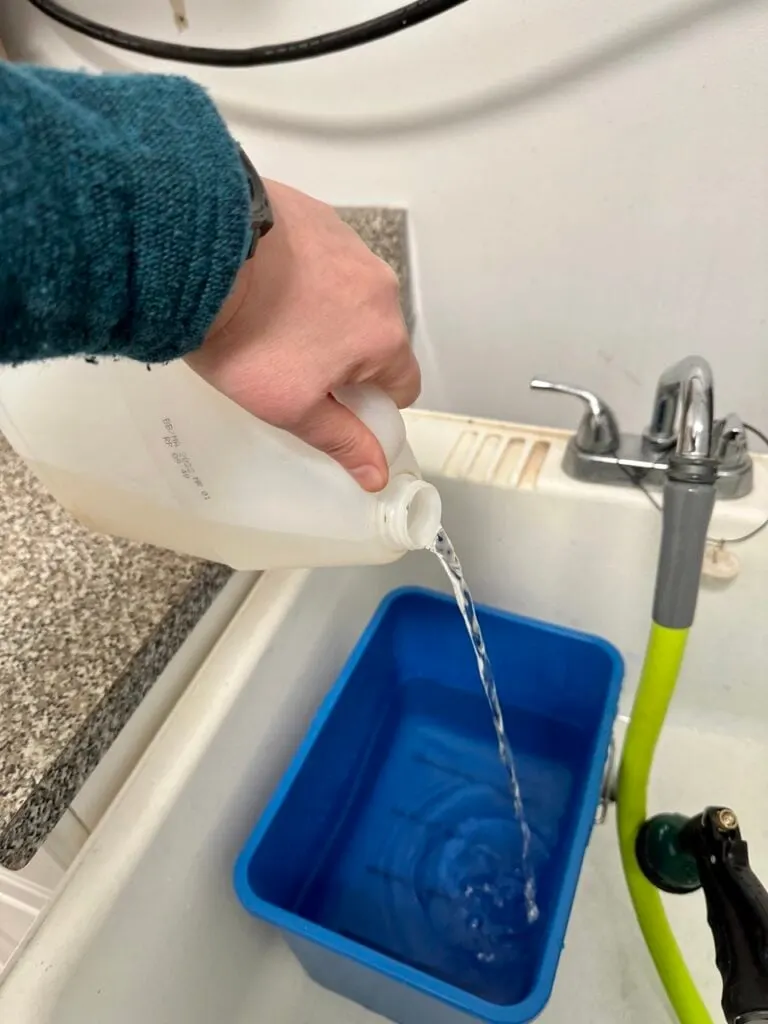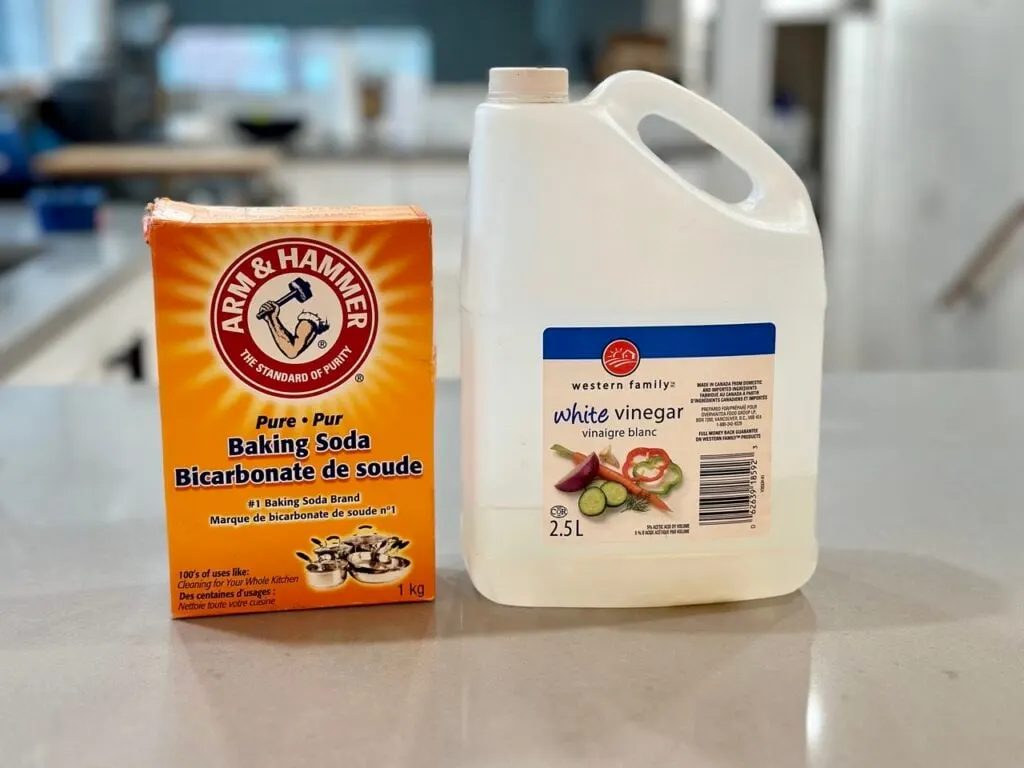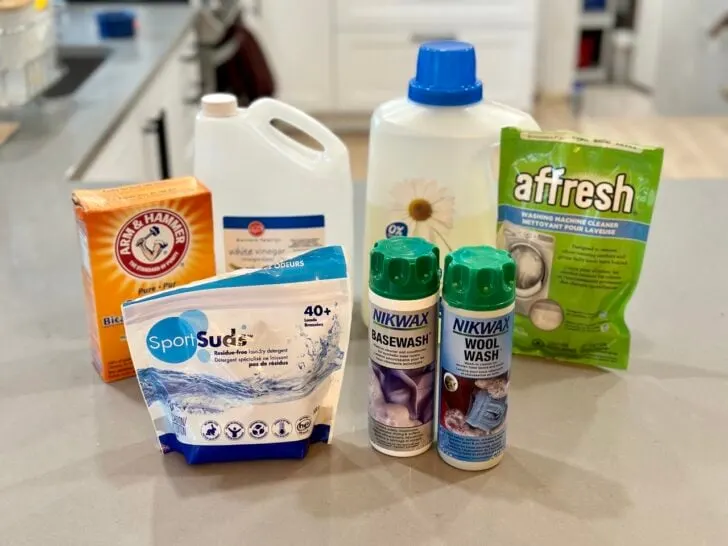If you’re human, you sweat when hiking. And that makes your hiking clothing smell bad. But you don’t have to throw away your stinky clothes. I’ve got a complete guide to getting the smell out of hiking clothes.
The advice in this guide covers hiking clothing like base layers (long underwear) shirts, pants, fleece jackets, underwear, sports bras, and socks. Rain jackets and down jackets need to be washed differently.
I’ve been hiking and backpacking for two decades, mostly in the Coast Mountains of British Columbia. (I even wrote a book about it.)
It isn’t that hot here, but it’s pretty humid, which means my hiking clothes are often sweaty and don’t get a chance to dry out until I get home. And all that moisture makes my clothing stink!
I also have hyperhidrosis, a medical condition that makes me sweat more than the average person. Even if I’m not working hard, my shirt, sports bra, underwear, and waistband of my pants are sweaty.
Since I hike a lot, most of my hiking clothes develop a gross funky smell over time. I pull them out of the drawer and they smell fine, but after an hour, you can smell the stink again. So I know a thing or two about getting the smell out of hiking clothes.
In this guide I’ll cover:
- Why do hiking clothes smell bad?
- How to prevent your hiking clothes from smelling bad
- How to get the smell out of hiking clothes
- Stinky hiking clothing myths
Hey there: Some of the links in this post are affiliate links, which means I earn a small commission at no cost to you. Thanks for your support. -Taryn
Why Do Hiking Clothes Stink?
When you hike, you sweat. Sweat itself doesn’t have any odor. But the bacteria and microbes on your skin loves moist environments. So when you sweat, that bacteria thrives, stinking up your armpits, crotch, feet, and anywhere else you sweat a lot.
Most hiking clothing wicks sweat and dries quickly, but unfortunately the bacteria don’t evaporate with the sweat – they stay in your clothes.. And hikers often wear their clothing on multi-day backpacking trips, building up sweat and bacteria for days, which translates into stinky hiking clothing.
Sometimes, that bacteria sticks around even after washing, which makes hiking clothing hold its smell and stink even when it’s “clean”. But you don’t have to get rid of it. Read on to find out how to get the smell out of your hiking clothes.
How to Prevent Your Hiking Clothes From Smelling Bad
Understand Which Fabrics Get Stinkier Than Others
Hiking clothing is typically made of synthetic materials like nylon or polyester. Another option is merino wool. Some fabrics hold on to smell more than others.
In general, wool is naturally anti-microbial, so it is much less likely to get stinky. On the other hand, synthetic fabrics tend to breed more microbes, leading to stink.
Synthetics tend to get get smelly because they don’t have the same anti-microbial properties. Nylon and polyester get stinky at about the same rate.
Curious if Merino wool is worth it? Read my Merino wool explainer and decide for yourself.
Choose Odor-Resistant Finishes and Fabrics
Cheap hiking clothes are just made with regular polyester and nylon. I find that my workout shirts and sports bras from Old Navy or Champion hold smells way more than my gear from Patagonia or Outdoor Research.
That’s because high-end hiking clothing often has an anti-microbial odor-resistant finish or uses an odor-resistant fabric.
Check labels and product information for brand name technologies such as Polygiene, ActiveFresh, Silverscent, or HeiQ. Or it might just be called “anti-odor” or “anti-microbial”.
There are two forms of this technology: an odor-resistant finish or an odor-resistant fabric. They both use silver-based additives that stop bacteria from reproducing.
The finishes are applied to fabric, which means that over time they will wash out. Odor-resistant fabrics have silver incorporated right into the fabric, so it will last for the lifetime of your garment.
Just a heads up: Some silver-based anti-odor treatments (mostly the no-name ones) have negative environmental impacts. If you are concerned, do some research and see if the benefits outweigh the impacts for you.
Wash ASAP
Don’t let bacteria and body oils soak into your hiking clothes – wash them as soon as possible. That way the odors won’t have time to develop.
Air It Out
If you can’t wash your hiking clothes right away, don’t leave them wet in your laundry hamper. That just provides a great breeding ground for bacteria and leads to more bad smells.
Hang them up to air out and dry. Inside out is best since there are more bacteria and oil on the inside of your clothing. On backpacking trips, I hang my hiking shirt, sports bra, and underwear up on a tree branch to dry out.
Soak It
If you are at home, soaking is an even better option than airing it out. Fill a bucket with cold water and add one cup of baking soda. Instead of baking soda, you can also add a little bit of detergent, vinegar, or some lemon juice.
Soaking your hiking clothes for as little as 30 minutes can make a big difference. But you can leave them as long as you need (within reason). When it’s time to do laundry, squeeze the water out, then pop your clothes in the washing machine as usual.

Clean Your Washing Machine
Until it started to smell, I didn’t know you were supposed clean your washing machine! I figured since it regularly has soap and hot water in it, it had to be clean.
It turns out oil, dirt, and residue can build up inside washing machines, which causes mold to grow, and that can get into your clothing. Front loaders need cleaning more often than to loaders.
Check your washing machine’s manual for cleaning instructions. Some have a cleaning setting. In general, you can run your washing machine on the hottest water setting and add a little bit of bleach or a few cups of vinegar or baking soda. But don’t ever combine them as that can be dangerous!
You can also use a dilute bleach or vinegar solution to clean the inside of the drum as well as the door seal and detergent drawer on front load washing machines.
I also like to use Affresh washing machine cleaning tablets every few months as they foam up to break down residue that can stuck in the crevices of my-front loading machine. It’s also much less work than hand-scrubbing.
How to Get the Smell Out of Hiking Clothes
Turn Inside Out When Washing
Your sweat, oil, and bacteria build up on the inside of your hiking clothes. So if you turn them inside out when you wash them, it’s easier for the detergent to get at the stinkiest parts of your clothes.
Use an Odor-Fighting Detergent
There are lots of odor-fighting detergents on the market designed to get sweat smells out of clothing.
But not all detergents are created equal. Lots of hiking clothing has a DWR (durable water repellency) or a finish designed to enhance wicking. Regular detergents can destroy these finishes.
Read the label on the detergent carefully to see what kinds of fabrics and clothing items it is recommended for. Some detergents contain bleach, which can damage synthetic fabrics and wool. And some contain enzymes, which are great for fighting odor, but will destroy wool.
For hiking clothing, look for detergents marketed as sports detergents.
I’ve used a few different types of odor-fighting detergents over the years. Right now my favourites are Nikwax Basewash and Sports Suds. Sport Suds is Canadian and a bit less expensive, but I think Nikwax works a little bit better.

Use the Right Detergent For the Fabric
Sports detergents or regular laundry detergent works well on synthetics like nylon and polyester.
Merino wool is naturally anti-microbial and can go longer between washings. But it does need to be washed eventually! Merino wool lasts the longest if you use special detergent.
The enzymes in some detergents can eat at the natural fibres of wool hiking clothing, breaking them down. I use Nikwax Wool Wash since it is designed to clean wool. Nikwax also claims that it helps improve wicking and accelerate drying, which leads to less microbe build-up.
Try An Enzyme Cleaner
Heavy-duty enzyme cleaners like Nature’s Miracle (for pet accidents) or Revivex Odor Eliminator (previous called MiraZyme and sold as a wetsuit cleaner) can help get the smell out of your hiking clothes. Both are fairly concentrated and expensive, so I don’t use them often.
I also find that sports detergents work fine on most smells – I don’t have to resort to using an enzyme cleaner.
And beware – don’t use these on wool. The enzymes break it down.
Use Hot Water
Hot water kills bacteria. Check the labels on your hiking clothing and wash them in the hottest water they can withstand.
But be careful with merino wool – hot water will shrink it! Always wash wool garments in cold water.
Add Baking Soda or Vinegar to Your Washing Machine
Baking soda and white vinegar are both natural ways to fight odors. You can add one cup of either to your washing machine each time you do a load of stinky hiking clothes. But don’t add both at once – that will create a science fair-style foamy eruption.

Skip the Dryer
The high heat of the dryer binds bacteria and body oils to fabric, which locks in the sink. Hang your hiking clothing to dry instead.
If possible, hang it in the direct sun where UV rays can further break down microbes and kill odor. However, drying your hiking clothes in the sun will fade their colors.
A bonus of air drying is that it will prolong the life of your hiking clothes. Most hiking clothing is made of technical fabrics with stretch properties. Air drying helps them keep their shape and won’t break down the elastic fibres they need to stay stretchy.

Don’t Use Fabric Softener
Fabric softeners make your clothing feel soft by coating them with a thin layer of waxy chemicals. That coating traps microbes, which makes your clothes stink.
It also impedes wicking and water repellency finishes as well as overall breathability – and those features are why you bought hiking clothing in the first place!
When in Doubt, Re-Wash
Give your clothing a sniff when once you have washed and dried it. Do they still smell? If so, try washing them again, perhaps with a specialty anti-odor detergent or with some added baking soda or vinegar in the washing machine.
I also find that sometimes clothing smells fine after it’s washed, but within an hour of putting it on, it smells again. In that case, I make sure to run it through an extra special cleaning process: a pre-soak, then a wash with anti-odor detergent, then line drying in the sun.
Stinky Hiking Clothing Myths
Freezing Your Clothing Will Get the Stink Out
You might have seen recommendations online to put your stinky clothing (especially jeans) in the freezer instead of washing them.
According to microbiologists, the microbes that live on your clothing are happiest living at human body temperature. However, many of them are adapted to survive low temperatures. So once your clothing warms up, the microbes wake back up and go back to being stinky.
That means that putting your clothing in the freezer won’t get the smell out.
Adding More Detergent Will Get Your Clothes Cleaner
Your instinct might be to douse your stinky hiking clothes in detergent. But if excess detergent isn’t completely rinsed out of your clothes, it provides a breeding ground for fungus and mildew. And that will just make your clothing smell even more!
Febreze Gets the Smell Out of Your Clothes
Febreze doesn’t get the smell out of clothes – it just stops them from smelling bad. I can hear you asking: “Isn’t that the same thing?” Nope!
It just hides the smell – it doesn’t get it out. Febreze uses chemical compounds called cyclodextrins made of sugar molecules to trap odor-causing molecules. The molecules are still there – but they are surrounded by cyclodextrins so they don’t smell bad.
If you spray Febreze on your shirt, it will stop smelling bad. But when you wash your shirt, you’ll wash out the Febreze. And if the odor molecules don’t get washed out as well, your hiking shirt will still smell terrible.
Febreze (especially unscented Febreze) is great for hard-to-wash hiking gear like sleeping bags or hiking boots, but it won’t permanently get the smell out of your hiking clothes.
So that’s everything you need to know about getting the smell out of your hiking clothes. Do you have tips to share or questions about getting your gear back to its pre-stink days? Leave them in the comments.
READ NEXT:
- Is Merino Wool Worth It? Pros and Cons
- Why Do Rain Jackets Wet Out?
- Best Hiking Underwear For Women and Men
- 12 Best Women’s Hiking Pants (Picks for Every Body Type)
- 19 Best Hiking Leggings of 2023
- How to Camp and Hike on Your Period
- Women’s Plus Size Hiking Clothes: The Best Brands and Where to Find Them
- Backpacking Checklist: Gear You Need To Go Backpacking
- Best Hiking Underwear For Women and Men - June 25, 2024
- 60 Cozy Cabins Near Vancouver for a Weekend Getaway - May 31, 2024
- The Ultimate Self-Guided Tour of Stockholm Subway Art - May 18, 2024


Cassandra K
Wednesday 26th of April 2023
Hi Taryn, Thanks for this guide and for sharing your experience and knowledge so generously. I have a couple of laundering ideas - oxygen bleach is less harmful to the environment than chlorine bleach and much better than Octyl Decyl Dimethyl Ammonium Chloride (the active ingredient in Lysol laundry sanitizer). Plus, oxygen bleach is generally ok on most fabrics. Soaking stinky socks with Oxi-clean powder for an hour before laundering really removes the stink. Wearing rubber gloves and using a bucket, dissolve the Oxi-clean powder in a bit of hot water first, then add 2-3 drops of dish detergent and more water so you are using the hottest water that is recommended for the fabric. Squeeze the socks at the beginning and end to work the solution through. Cover the bucket with a lid to keep the heat in. Another thought: after cleaning a front loader washing machine, always leave both the door and the detergent drawer open to air out. And don't leave wet laundry in the machine!
Enna
Thursday 23rd of March 2023
Thank you for this great guide, Taryn! I'd like to mention another detergent, Lysol Laundry Sanitizer Additive. I use it for underwear, but I also use it for sanitizing sports clothing. There's also an option specifically for sports clothing. The pricing is great, 1.2 L for $10.